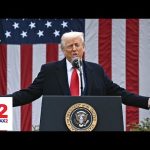President Trump’s “Liberation Day” tariff plan aims to reshape global trade by pressuring other nations to lower their tariffs on U.S. goods, with supporters arguing it will revive American manufacturing and curb unfair competition. While short-term economic pain is expected, former Trump advisor and allies claim the strategy will ultimately force trading partners to capitulate, unleashing long-term prosperity. Critics, however, warn of higher consumer prices and market volatility, as seen in the S&P 500’s worst quarterly performance since 2022. Let’s examine the key arguments.
### The Strategy Behind the Tariffs
Trump’s plan imposes on nearly all U.S. trading partners, targeting countries that charge high levies on American products. The goal is to create a “level playing field” by compelling nations like China, India, and Mexico to reduce their tariffs (averaging 20% or more) to match U.S. rates (3-5%). Moore argues this could trigger a global tariff reduction, calling it “liberation from unfair trade practices”. For example, Israel has already begun lowering tariffs preemptively.
:
– : Prices for imported goods (e.g., cars, pharmaceuticals) will rise, with auto tariffs taking effect tonight. Analysts warn GM is especially vulnerable, as only 45% of its U.S.-sold vehicles are made domestically vs. Ford’s 80%.
– : Trump’s team views tariffs as a bargaining chip. Treasury Secretary Scott Bessent claims countries like the U.K. and India are negotiating deals to avoid tariffs.
– : Advisers are split. Peter Navarro predicts $6 trillion in revenue for middle-class tax cuts, while Moore insists the focus is on lowering foreign tariffs, not raising U.S. rates.
### Will Manufacturing Jobs Return?
Proponents point to Trump’s first-term record: a 50-100% stock market surge and renewed manufacturing optimism. Moore predicts tariffs will incentivize companies to “reshore” production, citing America’s $15 trillion consumer market as irreplaceable for foreign economies. Critics counter that supply chains can’t shift overnight, and retaliatory tariffs (e.g., Canada’s 20% levy on U.S. steel) risk prolonged trade wars.
:
– : Moore urges pairing tariffs with deregulation and tax cuts to offset business costs.
– : China, which exports $500 billion annually to the U.S., faces “Great Depression”-level fallout if shut out, pressuring concessions.
– : 58% of Americans fear tariffs will raise prices, per a CBS poll.
### The Road Ahead
While Trump’s allies project confidence in his negotiating skills, the timeline remains uncertain. Moore admits “short-term pain” but predicts resolutions “within months”. Auto tariffs starting tonight will test this theory. Meanwhile, Republicans like Mitch McConnell and Rand Paul oppose the plan, highlighting GOP divisions.
: The tariffs’ success hinges on foreign capitulation. If trading partners back down, U.S. manufacturing could see a renaissance. If not, stagnation and inflation loom. As Moore puts it: “Trump is the best negotiator I’ve ever met…but this is a dangerous game”. The next 6–12 months will determine whether “Liberation Day” marks a turning point or a miscalculation.




